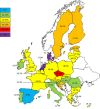European Sitting Championship: Prevalence and Correlates of Self-Reported Sitting Time in the 28 European Union Member States
- PMID: 26934701
- PMCID: PMC4774909
- DOI: 10.1371/journal.pone.0149320
European Sitting Championship: Prevalence and Correlates of Self-Reported Sitting Time in the 28 European Union Member States
Abstract
Objective: Sedentary behaviour is increasingly recognized as an important health risk, but comparable data across Europe are scarce. The objective of this study was to explore the prevalence and correlates of self-reported sitting time in adults across and within the 28 European Union Member States.
Methods: This study reports data from the Special Eurobarometer 412. In 2013, 27,919 randomly selected Europeans (approximately 1000 per Member State) were interviewed face-to-face. Sitting time on a usual day was self-reported and dichotomised into sitting less- and more than 7.5 hours per day. Uni- and multivariate odds ratios of sitting more than 7.5 hours per day were assessed by country and socio-demographic variables using binary logistic regression analyses. The analyses were stratified by country to study the socio-demographic correlates of sitting time within the different countries.
Results: A total of 26,617 respondents were included in the analyses. Median sitting time was five hours per day. Across Europe, 18.5 percent of the respondents reported to sit more than 7.5 hours per day, with substantial variation between countries (ranging from 8.9 to 32.1 percent). In general, northern European countries reported more sitting than countries in the south of Europe. 'Current occupation' and 'age when stopped education' were found to be the strongest correlates of sitting time, both across Europe and within most Member States. Compared to manual workers, the odds ratio of sitting more than 7.5 hours per day was 5.00 for people with white collar occupations, 3.84 for students, and 3.65 for managers.
Conclusions: There is substantial variation in self-reported sitting time among European adults across countries as well as socio-demographic groups. While regular surveillance of (objectively measured) sedentary behaviour is needed, the results of this study provide entry points for developing targeted interventions aimed at highly sedentary populations, such as people with sedentary occupations.
Conflict of interest statement
Figures



References
Publication types
MeSH terms
LinkOut - more resources
Full Text Sources
Other Literature Sources
Medical

